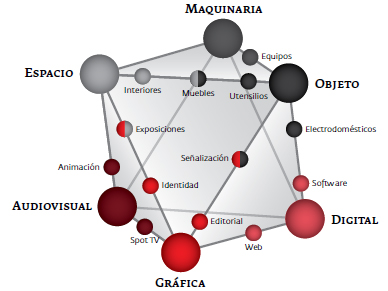DESIGN. The object of the profession.
##plugins.themes.bootstrap3.article.main##
Abstract
The article defines the object of the profession of design for the national level, resulting from the need for a detailed characterization of this activity, which becomes a reference of the profession. This definition allows a visualization of the designers and their performance in work settings, from a current and prospective position. It will provide a description of the features that designers should have, their skills; knowledge required for the pursuit of design and their modes of action, depending on the tasks demand it. The object of the profession is a basis for the creation of curricula, undergraduate and graduate, provides a benchmark for assessing the quality of training and performance evaluation, contains the necessary elements for the characterization of a post work, selection, hiring and use of Designer, as well as for determining pay scales, rates and criteria for compensation, being the raw material to describe the professional model.
##plugins.themes.bootstrap3.article.details##

This work is licensed under a Creative Commons Attribution-NonCommercial-ShareAlike 4.0 International License.
- Attribution — You must give appropriate credit , provide a link to the license, and indicate if changes were made . You may do so in any reasonable manner, but not in any way that suggests the licensor endorses you or your use.
- NonCommercial — You may not use the material for commercial purposes .
- No additional restrictions — You may not apply legal terms or technological measures that legally restrict others from doing anything the license permits.
- ShareAlike — If you remix, transform, or build upon the material, you must distribute your contribution under the same license as the original. NOTE: This point applies to numbers 1 to 20 of the magazine with the previous CC-BY-NC-SA 4.0 license. Does not apply to the new CC BY-NC 4.0 license from Volume 11, Number. 21 (2024).
References
Álvarez, C. (2001) El diseño curricular. Ed. Pueblo y educación. La Habana.
Bazinet, A. (1984) La Evaluación del Rendimiento. Ed. Herder, Barcelona.
Bor, J.M. (1996)Ecodiseño y Desarrollo Sostenible. Situación: revista de coyuntura económica, ISSN 0213-2273, 2,117-129.
Bonsiepe, G. (2006) Las Siete Columnas del Diseño. Ed. Gustavo Gili. Barcelona.
Calificador de Cargos de Diseño para el MTSS. (2000) Oficina nacional de Diseño ONDI. Cuba .
Chartered Society of Designer (2009) http: //www. cds.org.uk.
Guía Metodológica PREDICA (2000).“Cómo integrar el diseño en su empresa”. Madrid.
Grupo Educación. (2007)Programa director para el reforzamiento de la formación de valores en la sociedad Cubana actual. MES. Cuba.
Hernández, A. (2003) El Perfil Profesional, CEPES, Universidad de la Habana. Cuba.
Horruitiner, P. (2006) La Universidad cubana. El modelo de formación. Ed. Félix Varela. Cuba.
Lecuona, M. (2003) Conceptos básicos de la gestión del diseño en las pymes. Edición Servicio de Publicaciones UPV.
Libro Blanco. (2008) Títulos de Grado en Bellas Artes / Diseño / Restauración. Agencia Nacional de Evaluación de la Calidad y Acreditación. España.
Montaña J. Moll, I. (2008),La gestión del Diseño en la empresa. Fundación COTEC. Madrid.
Morin, E., (2004) La Epistemología de la Complejidad. Gaceta de Antropología, 20. París.
Núñez, J. (1999) La Ciencia y la Tecnología como procesos sociales. Ed. Felix Varela. Cuba.
Peña, S. (2008) “Propuesta de Currículo para la formación de diseñadores” Tesis para obtener en Título de Máster en Diseño Industrial. ISDi. Cuba.
Rubinstein, S. L. (2007) Las capacidades. Selección de lecturas de Psicología de las capacidades.E.González Puig, MES, Cuba.
Tresserras, J., Verdaguer, N. y Espinach, X. (2001) Èxit de Mercat i Disseny. Centre d’Innovació iDesenvolupament Empresarial (CIDEM). Catalunya, España.






















